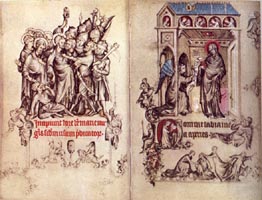

One of the most extraordinary monuments of fourteenth century art is a prayer book in the Cloisters in New York City. Its size (94 X64 mm (3 5/8 X 2 3/8 inches) appears to hardly justify its characterization as a monument, but closer examination reveals its extraordinary nature. The manuscript has been identified with a book described in the 1401 and 1416 inventories of the collection of Jean, Duc de Berry: "Item une petites heures de Nostre Dame, nommée Heures de Pucelle, enlumées de blanc et de noir, à la usaige des Prescheurs" ("Item: a little hours of Our Lady, called the Hours of Pucelle, illuminated in black and white, in the Dominican usage"). The inventories identify the book as "The Hours of Pucelle," and is described as being "illuminated in black and white for the use of the Preachers." The use of this technique of tones of gray known as "grisaille" is exceptional in a book of the early fourteenth century. The rubric beneath the miniature of the Arrest of Christ states that the manuscript is made for the "usum predicatorum" or the "use of the preachers (Dominicans)." An entry in the inventory of Charles V's jewels at Vincennes is consistent with the Berry entries. Here the manuscript is described as being bound with the Arms of Queen Jeanne d'Évreux. The preciousness of this book is suggested by its inclusion in the inventory of jewels and not as part of the Charles V's library. An entry in the will of Jeanne d'Évreux of 1371 lists a "petit livret d'oraisons" that was bequeathed to her nephew Charles V: "un bien petit livret d'oroisons que le roy Charles, dont Dieu l'ame, avoit faict faire pour Madame, que pucelle enlumina" ("a very small prayer book which King Charles, may God protect him, had made for Madame, which Pucelle illuminated"). This entry also reitterates that the book was made by Pucelle and that it had been commissioned by her husband Charles IV who reigned between 1325 and 1328. In all likelihood, Charles presented the book to the fourteen year old Jeanne as a wedding present in 1324.
This documentary evidence does not only serve to identify the Cloisters book as the Hours of Queen Jeanne d'Evreux, but it also intimates at how it was appreciated as extraordinary during its own period. The direct reference to Pucelle in the will of Jeanne d'Evreux written nearly forty years after the book was produced and the reappearance of Pucelle's name in the inventories of Jean de Berry are extraordinary at this period. A major shift we will see during the art of the Northern Renaissance is the emergence of the artist as a name associated with a distinct style from the anonymity of the Medieval tradition. Jean de Berry who was the major patron of fine books at the end of the fourteenth and the beginning of the fifteenth century was clearly aware of the authority of Pucelle's works. One of the earliest Books of Hours made for the Duke of Berry, the Petites heures, as we will see, contains works by a close follower of Pucelle painted nearly fifty years later than the Hours of Jeanne d'Evreux. The Duke's continued interest in the art of Pucelle can be seen in the borrowings from Pucelle evident in the Duke's Grandes Heures produced about 1410.
Hours of Jeanne d'Evreux, folio 160. |
Grandes Heures, made for John of Berry, folio 11 |
Examination of the book itself reveals that it is a tour de force. The small size of the book and the use of the grisaille technique are also highly unusual at this date. Whereas we will see that manuscripts were regularly the product of collaboration with different specialists responsible for the scribal work, decoration, and the illustration, the Hours of Jeanne d'Evreux was largely the work of Pucelle. Although a separate scribe was responsible for transcribing the text, many of the unique features of the manuscript including its small size and illustrative plan had already been planned for before the scribe began work. We can not be certain what role Pucelle played in the original laying out of the book, but once the scribe had completed his stint, the remaining stages were carried out by Pucelle. The decorative forms including initials, historiated initials, and the text and border decoration all appear to be by the same maker as the miniatures. The book avoids the period's conventional decorative designs of patterns of rinceau leaves, and employs highly inventive marginal figures or drolleries. The decoration and illustration are very creatively integrated here. This is evident in the opening page of the Hours of the Virgin where a drollery projecting from a line ending in the text reaches up and supports the building housing the Annunciation.
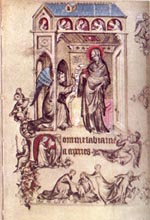
Note here also the very creative treatment of the opening historiated initial where the "D" becomes its own structure housing Jeanne d'Evreux while a guards sits to the left of the initial barring entrance into the Queen's space.
The illustrative plan of the manuscript is also exceptional. This is evident in the Hours of the Virgin. It was already conventional in this period to open each hour with a half-page miniature illustrating an episode in the infancy story of Christ. In the Hours of Jeanne d'Evreux each hour is introduced with two miniatures, a full-page miniature illustrating an episode from the Passion of Christ paired with on the facing page opening the new text an illustration from the infancy of Christ:

|
||||
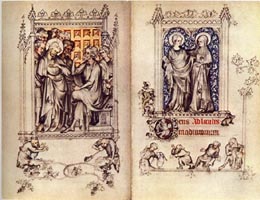
 Prime Prime
|
||||
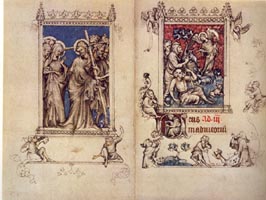
|
||||
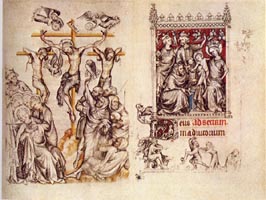
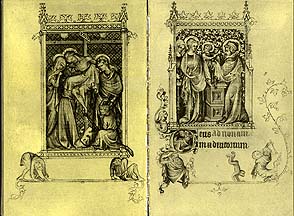
|
||||
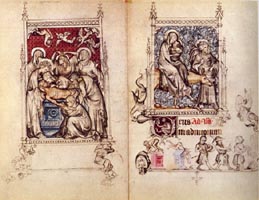
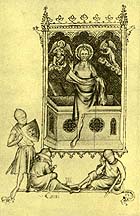
|
The juxtaposition of the Passion and Infancy cycles appears to connect to the idea of the Joys and Sorrows of the Virgin. Devotional literature of the period regularly focuses on the emotional state of the Virgin and the contrast between her joy at the birth of her Son and her sorrow at his Passion. Closer examination of the pages suggests more developed thematic interrelationships. This can be seen in the opening for Matins:

Here Judas greeting Christ with the kiss as the sign of Betrayal is juxtaposed to the angelic salutation of Gabriel to the Virgin. The image in the bas-de-page which appears to be a Medieval form of the game "Blind Man's Bluff" is apparently intentionally juxtaposed to the buffeting of Christ on the facing page.
The page opening Lauds appears to be also thematically coordinated:
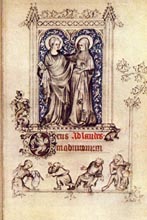
The miniature shows the Visitation where Mary and Elizabeth greet each other and both acknowledge that they are with child. This theme of procreation appears to be echoed in the rabbit that appears to be supporting the bottom right corner of the structure. The bas-de-page shows what has been identified as a peasant charivari, the raucous celebration of a wedding night. Attention is drawn to the bag-pipe being held by the figure on the left. The phallic associations of the bag-pipe and its limp form is perhaps a reference to the virgin birth. We can imagine how Jeanne d'Evreux would have taken this detail since central to her role as Queen was to bear a male heir to the throne. Her failure to do so led to the end of the Capetian Dynasty and the beginning of the Valois Dynasty and the Hundred Years War.
Art Historians have long pointed to the revolutionary nature of these miniatures. Here we see an attempt by a northern artist to represent illusionistic space. This is very evident in comparing one of the miniature from the Life of St Denis manuscript to the image of the Annunciation in the Hours of Jeanne d'Evreux:
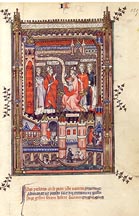

In the earlier miniature there is little sense of the figures as being placed in the structure, but rather the figures appear to be alligned along a ground line. While spatial elements are present especially in the bridge scene beneath, the artist displays a strong sense of the integrity of the two dimensional surface of the page. In the Hours of Jeanne d'Evreux, Pucelle has created the illusion of a three dimensional interior. We feel the figures are placed on a ground plane that recedes into depth. Note particularly the detail of the angel being placed inside the antechamber on the left. Tonal gradations of light and shadow reinforce the illusion of depth and likewise bring out the solidity of the figures. Pucelle reinforces the sense of the solidity of the building by having the figure emerging from the line ending actively supporting the structure. Other miniatures show Atlas-like figures straining under the weight of the structures they support:

The spatial depth and solidity of the figures are linked to an exploration of the emotional depth of the scenes. This is perhaps best represented by the range of pathos illustrated in the illustration of the Entombment:
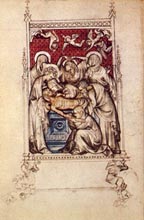
The range of emotions is extraordinary from the tender gesture of the figure touching Christ's hand at the bottom to the up-raised hands of the wailing Mary Magdalene. Even the figures whose faces are buried in their robes evoke strong emotional responses. All of these details are still secondary to that of Mary peering into the eyes of her dead son.
These innovations have long been explained as the result of the influence of Italian Trecento art on Pucelle. The compositions in the Hours of Jeanne d'Evreux demonstrate a familiarity with the famous altarpiece entitled the Maestà that the Sienese painter Duccio completed in 1311 for Siena Cathedral. For example Duccio's representation of Annunciation of the Death of the Virgin shows strong parallels to Pucelle's representation of the Annunciation:

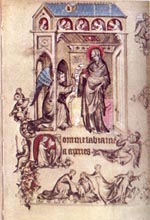
Similarly there are important parallels between the two artists' representation of the Crucifixion:
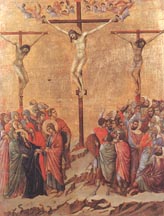

Comparably the Duccio's and Pucelle's representations of the Entombment are closely related:
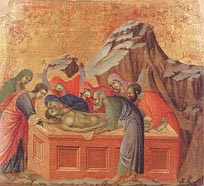
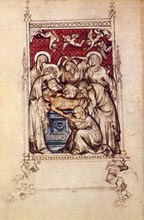

As demonstrated by an article written by Stanley Ferber (Art Bulletin, 66 ( 1984), pp.65-72), Pucelle's awareness of Italian art was not limited to the work of Duccio. Ferber has indicated Pucelle's indebtedness to the work of the late thirteenth and early fourteenth century sculptor Giovanni Pisano. Details of Pisano's Pistoia Pulpit completed in 1301 show significant parallels to the work of Pucelle.
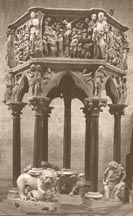
Details of Pisano's Massacre of the Innocents show intriguing parallels to Pucelle's representation of the same subject matter in the bas-de-page for Sextam:
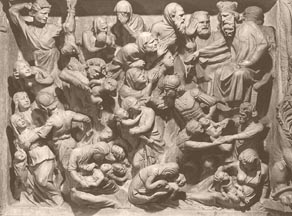
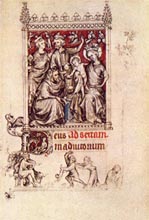
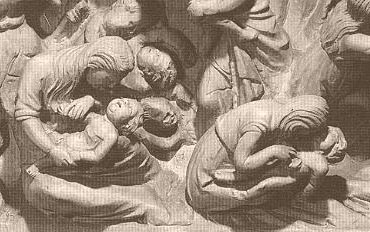
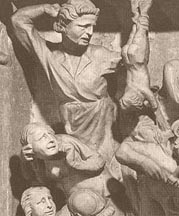
Pisano's representation of the Crucifixion includes details found in Pucelle's version that are not found in Duccio's painting. For example, both Pisano and Pucelle show the thieves's arms wrapped over the crossbars of their crosses:
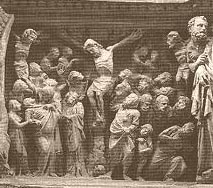

The Atlas-like figure of St. Matthew that helps support the pulpit is intriguingly close to the figures supporting many of the miniatures:
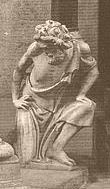
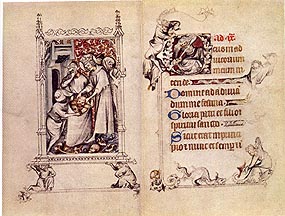
While it is reasonable to suppose that Duccio made a trip to Italy to see these works, we cannot be certain. A model book by some other artist could be a potential source. This connection of Pucelle's art to Italian trecento art does illustrate Erwin Panofsky's famous characterization of Parisian art as a reservoir which developed through the mixing of different sources. At the same time as acknowledging the relationship to Italian art, we have to be careful not to treat Pucelle's work as subservient to the foreign tradition. The Pucelle style integrates the Italianate elements with the artistic currents of Paris.
Fourteenth century Paris was the center of luxury arts, including manuscripts, jewelry, gold work, fine enamels, and clothing. Aristocrats were fascinated with exquisite works made of precious materials. One of these luxury arts that appealed to the tastes of French noblewomen of the fourteenth century were ivories. A good number of objects made of ivory have come down to us including combs, mirror backs, jewel boxes, and small scale devotional objects. Among the latter group would be diptychs, relief panels, small statues, tabernacles, and devotional booklets. Like the books of hours, ivories were symbols of status and devotion. The small size of many of the books of hours and ivory devotional objects indicate that they were made for private devotion. The figure style in both the ivories and manuscripts emphasize elegance of costume, gracefulness and refinement of pose and gesture. Compare for example the standing Virgin from a devotional tabernacle to the Virgin in the Annunciation from the Hours of Jeanne d'Evreux:
Note the elegant "S" curve of both figures. Pucelle seems to have expected his audience to see the parallels between these two figures. Note how in the traditional Virgin and Child figure, the Christ child is being partially supported by the raised hip, while in the Hours of Jeanne d'Evreux a book is substituted for the Christ Child. The book would be understood as a symbol for Christ, the Word.
The grisaille technique used in the Hours of Jeanne d'Evreux strongly resembles the effect of Gothic ivories. This is even more evident when it is remembered that the ivories originally were painted. A German diptych in the Cleveland Museum of Art still preserves the original paint:
The pigment is largely reserved for the background and architectural context. Except for gilt embellishments, the figures are left unpainted. This is very close to the effect of the miniatures in the Hours of Jeanne d'Evreux. The architectural frameworks of the miniatures echo those found in the ivories.
An explanation for why Pucelle might have emulated ivories in the Hours of Jeanne d'Evreux can be found when it is understood that the ivories appear to have been produced for noblewomen. Wouldn't the beautiful creamy white color of the ivories be seen as like the skin of a noblewoman? Even the objects that were made in ivory, like the jewel caskets, combs, and mirrors, were associated with female beauty. The subject matter of both the religious and secular ivories is predominantly made for a female audience. The secular images focus on Romantic love. Absent is any epic heroic imagery more characteristic of male patronage. We do not find images of the Trojan war or the exploits of Medieval heroes, that are so well represented in the larger, more public tapestries. Even the devotional pieces are inflected for a female audience. This is especially evident in the large number of images of the Virgin and Child that appear in the ivories, but even the narrative scenes relate to a female audience. Consider for example the beautiful ivory diptych in Amsterdam:
While illustrating important moments in the life of Christ, the figure of the Virgin is given special emphasis in each scene. In the Nativity she dominates the lower half of the scene. Much of the emphasis in the scene is on her tender gaze as she looks down at Christ. In the Adoration of the Magi, the kings' honoring of Christ is balanced by the crowning of the Virgin by an angel. The swooning Virgin almost steals the stage from the crucified Christ, while in the Last Judgement image, Christ looks down at His mother who appeals to him as an intercessor. This female inflexion is generally characteristic of the devotional ivories.
Many of the
secular ivories like this mirror back showing a game of chess in the Louvre
collection remind us of another another distinctive northern element evident
in the Hours of Jeanne d'Evreux. Scenes of courtly elegance like this chess
game are enframed by fanciful hybrid creatures. 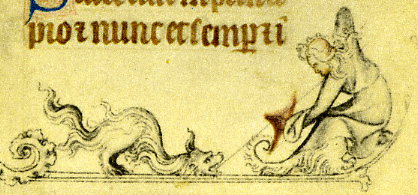 The
monsters that frame this ivory make a nice comparison to marginal details of
the Hours of Jeanne d'Evreux like the monster in the bas-de-page on the opening
of Nones of the Hours of St. Louis (folio
160).
The
monsters that frame this ivory make a nice comparison to marginal details of
the Hours of Jeanne d'Evreux like the monster in the bas-de-page on the opening
of Nones of the Hours of St. Louis (folio
160). 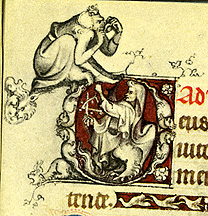 The
frame of the mirror can also be compared to initials like the letter "D"
on folio 166. The marginal world of the Hours of Jeanne d'Evreux is one of the
most remarkable examples of the medieval fascination with drolleries and grotesques.
Like the literary form the fabliaux where the courtly world is turned
upside down, the marginal figures in the Hours of Jeanne d'Evreux are full of
antitheses. Courtly refinement of the nobility is here juxtaposed in the margins
with the bawdy carnality of the lower classes. In this marginal world, the natural
order of clear divisions of different states of being. Categories of human,
animal, vegetable, and mineral are mixed in the fabulous creatures in the margins.
The Russian literary theorist Mikhail Bakhtin has emphasized the importance
of what he has characterized as the carnivalesque imagination in medieval culture
that was in intentional opposition to the official order of feasts of the church.
Bakhtin summarizes:
The
frame of the mirror can also be compared to initials like the letter "D"
on folio 166. The marginal world of the Hours of Jeanne d'Evreux is one of the
most remarkable examples of the medieval fascination with drolleries and grotesques.
Like the literary form the fabliaux where the courtly world is turned
upside down, the marginal figures in the Hours of Jeanne d'Evreux are full of
antitheses. Courtly refinement of the nobility is here juxtaposed in the margins
with the bawdy carnality of the lower classes. In this marginal world, the natural
order of clear divisions of different states of being. Categories of human,
animal, vegetable, and mineral are mixed in the fabulous creatures in the margins.
The Russian literary theorist Mikhail Bakhtin has emphasized the importance
of what he has characterized as the carnivalesque imagination in medieval culture
that was in intentional opposition to the official order of feasts of the church.
Bakhtin summarizes:
| The men of the Middle Ages participated in two lives: the official and the carnival life. Two aspects of the world, the serious and the laughing aspect, co-existed in their consciousness. The co-existence was strikingly reflected in thirteenth and fourteenth-century illuminated manuscripts...Here we find on the same page strictly pious illustrations...as well as free designs not connected with the story. The free designs represent chimeras (fantastic forms combining human, animal, and vegetable elements), comic devils, jugglers performing acrobatic tricks, masquereade figures, and parodical scenes --that is, purely grotesque carnivalesque themes. All these pictures are shown on the same page, which like medieval man's consciousness contains both aspects of life and the world. Not only miniatures but the decorations of medieval churches, as well as religious sculpture, present a similar coexistence of the pious and the grotesque....However, in medieval art a strict dividing line is drawn between the pious and the grotesque; they exist side by side but never merge [Rabelais and His World, p. 96]. |
The world of the carnival and grotesque was an inversion of the world of official religion. In having the drunken whore play the Virgin and the fool play the king, the carnivalesque did not deny the dominant culture, but in its inversions, it validates the official world.
What we see in the margins of the Hours of Jeanne d'Evreux are echoes of the gargoyles of Gothic cathedrals and anticipations of the sixteenth century texts of Rabelais and the art of Brueghel. A particularly good example can be found in the choir stalls of sanctuaries of many churches. For example in the cathedral of Geneva there is an early sixteenth century choir stall. Prominent images of the disciples of Christ dominate, but below one finds the misericords, or ledges against which clergy can lean during lengthy services. Here is found the carnivaleque humor and fanciful creatures.:
Suggestions for further reading:
Avril, François, Manuscript Painting at the Court of France: the Fourteenth Century, Braziller, 1978.
Bakhtin, Mikhail, Rabelais and His World, trans. Hélène Iswolsky, 1984.
Camille, Michael, Image on the Edge: The Margins of Medieval Art, Cambridge, Mass, 1992.
Caviness, Madeline H. "Patron or Matron? A Capetian Bride and a Vade Mecum for Her Marriage Bed," In Studying Medieval Women: Sex, Gender, Feminism, edited by Nancy F. Partner, Cambridge, Mass: Medieval Academy of America, 1993, pp. 31-60.
Holladay, Joan A. "The Education of Jeanne d'Évreux: Personal Piety and Dynastic Salvation in Her Book of Hours at the Cloisters," Art History,17, 1994, 585-611.
Morand, Kathleen, Jean Pucelle, Oxford, 1962.
Randall, Lilian M.C. "Games and the Passion in Pucelle's Hours of Jeanne d'Évreux," Speculum, 47 (1972), pp. 246-257.